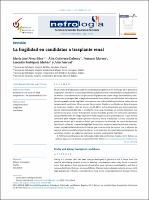La fragilidad en candidatos a trasplante renal
Author
Date
2021-05Permanent link
https://hdl.handle.net/11351/6879DOI
10.1016/j.nefro.2020.09.004
ISSN
0211-6995
PMID
33339673
Abstract
Frailty is a concept that has been mainly developed in geriatrics and it came from the need of identifying subjects at risk to develop complications when they faced a stressful event. Frail patients have higher risk of mortality, poor outcomes and disability, and this is independent from their age or comorbidities. Chronic kidney disease patients present with high prevalence of frailty, especially those who are in renal replacement therapy. Frail or pre-frail patients on the kidney transplant waiting list represent 20-30%, and these patients are proven to have poorer results after the transplant, which is a stressful event itself. Tools for frailty assessment, both scales or indexes, may be usefulto identify which subjects might be at risk for complications after transplant, and this is necessary to adapt our clinical practice and minimize morbidity. The most used frailty scale in kidney patients is Fried scale, which is based in five phenotypic items. Besides that, knowing frail population allows potential interventions such as prehabilitation while the patient is waiting for the kidney transplant, which the aim of improving their vulnerability prior to transplant and, therefore, optimizing results after transplant. More studies are needed amongst kidney patients to improve and prevent frailty
Keywords
Candidate; Frailty; Kidney transplantBibliographic citation
Pérez-Sáez MJ, Gutiérrez-Dalmau Á, Moreso F, Rodríguez Mañas L, Pascual J. La fragilidad en candidatos a trasplante renal. Nefrologia. 2021 May;41(3):237–43.
Audience
Professionals
This item appears in following collections
- HVH - Articles científics [4476]
The following license files are associated with this item:

 Private area
Private area Contact Us
Contact Us








